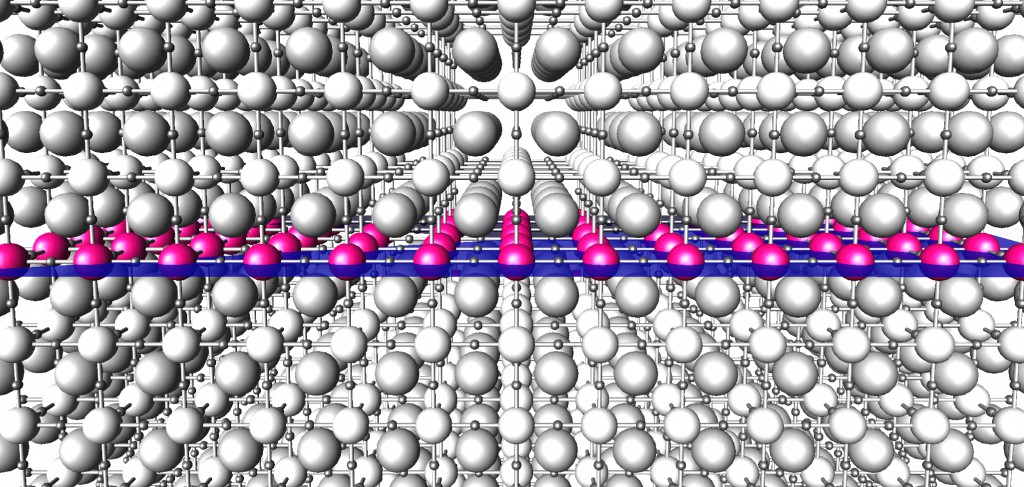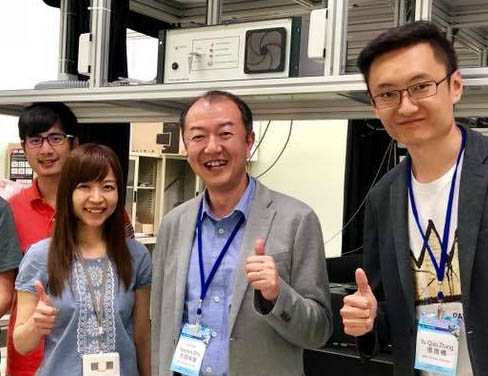Press release
Electron sandwich doubles thermoelectric performance
Researchers more than doubled the ability of a material to convert heat into electricity, which could help reduce the amount of wasted heat, and thus wasted fossil fuel, in daily activities and industries.
 Conceptual drawing of the superlattice in which spread electrons are confined to a narrow space to enhance thermoelectric conversion.
Conceptual drawing of the superlattice in which spread electrons are confined to a narrow space to enhance thermoelectric conversion.
Researchers from Hokkaido University and their colleagues in Japan and Taiwan have improved the ability to transform wasted heat into usable electricity by significantly narrowing the space through which spread electrons move, according to a new study published in the journal Nature Communications. More than 60 percent of energy produced by fossil fuels is lost as waste heat. One way to address this problem is to convert the wasted heat into electricity, known as thermoelectric energy conversion. However, improving the conversion rate has been difficult because of a trade-off relationship between the required properties within the material. Thermoelectric materials convert heat into electricity when there is a temperature difference, a phenomenon known as the Seebeck effect. Scientists have been investigating ways to confine electrons to a narrow space as a way to enhance conversion rates. In 2007, researchers built an artificial superlattice composed of conducting ultrathin layers sandwiched by thick insulating layers. This method yielded higher voltage but did not improve conversion rates. Researchers have predicted that performance can be significantly improved if electrons with longer de Broglie wavelength, which means they are more spread, are confined into a narrow conducting layer, but it had not yet been proven experimentally. The research team, led by Hiromichi Ohta of Hokkaido University, designed a superlattice in which electrons are spread by 30 percent wider as compared to previous experiments. This resulted in much higher voltage and doubled the thermoelectric conversion rate recorded from previous methods. “This is a significant step forward towards reducing the amount of heat wasted by power plants, factories, automobiles, computers, and even human bodies” says Hiromichi Ohta of Hokkaido University.
Original release
Hokkaido University, National Chiao Tung University, Phys.org, EurekAlert, ScienceDaily
[1] 日刊工業新聞,「電子閉じ込めで熱電変換向上 北大」, 2018年6月21日 27面, [2] OPTRONICS ONLINE, “北大、熱電変換材料の性能を2倍にできることを実証”, 2018年6月21日, [3] Fabcross for エンジニア, “熱電材料の性能を従来比2倍に増強―北大、電子を狭い空間に閉じ込め熱電材料を高性能化する理論を実証”, 2018年6月22日, [4] “Electron Sandwich Doubles Thermoelectric Performance”, I Connect 007, June 20, 2018, [5] “Electron Sandwich Doubles Thermoelectric Performance”, Chem Europe.com, June 21, 2018, [6] “Electron Sandwich Doubles Thermoelectric Performance”, Tech Explorist, June 20, 2018, [7] “Electron Sandwich Doubles Thermoelectric Performance”, Photonics Online, June 20, 2018, [8] “Electron Sandwich Doubles Thermoelectric Performance”, Spinoff.com, June 20, 2018, [9] “Electron Sandwich Doubles Thermoelectric Performance”, Phys.org, June 20, 2018, [10] “Artificial Superlattice Yields Higher Voltage and Improves Thermoelectric Conversion Rate”, AZO Materials, June 21, 2018, [11] “Electron sandwich doubles thermoelectric performance”, EurekAlert!, June 20, 2018, [12] “Electron sandwich doubles thermoelectric performance”, Science Daily, June 20, 2018, [13] “交通大學與北海道大學跨校合作 研發電子三明治使熱電性能倍增”, National Chiao Tung University, June 20, 2018, [14] “Electron sandwich doubles the thermoelectric performance!”, Device & Materials Engineering, Nature Research, June 20, 2018, [15] “Electron sandwich doubles thermoelectric performance”, Science & Technology Research News, June 20, 2018, [16] “Electron sandwich doubles thermoelectric performance”, Revolution Green, June 21, 2018, [17] “Electron sandwich doubles thermoelectric performance, BrightSurf.com, June 20, 2018, [18] “Electron sandwich doubles thermoelectric efficiency (News)”, PressCute.com, June 20, 2018, [19] “Electron sandwich doubles thermoelectric performance”, Green Car Congress, June 25, 2018, [20] “Electron sandwich doubles thermoelectric performance”, Innovations Report, June 20, 2018, [21] “Artificial Superlattice Yields Higher Voltage and Improves Thermoelectric Conversion Rate”, Converter News, June 21, 2018, [22] “Tech: Electron sandwich doubles thermoelectric performance — (Report)”, TuniseSoir News, June 20, 2018, [23] “Electron sandwich doubles thermoelectric performance”, Nanowerk, June 20, 2018, [24] “Electron sandwich doubles thermoelectric performance”, Programming News Payments & Trade Networks, June 27, 2018, [25] “Electron sandwich doubles thermoelectric performance”, Technology News, June 20, 2018, [26] “Electron sandwich doubles thermoelectric performance”, ECN, June 20, 2018, [27] “Thermoelectric performnce doubles in electron sandwich”, New Energy and Fuel, June 27, 2018, [28] “Researches Improve Ability Of Material To Convert Heat Into Electricity”, Chem Info, June 21, 2018, [29] 日刊工業新聞, 「車の廃熱再利用」, 2018年6月28日, [30] dmenu ニュース, 「自動車エンジンまわりの熱を電気に変換する材料開発へ」, 2018年6月28日, [31] “Nature子刊:研究人员将热电材料的转化效率提高了一倍多”, 中国材料网, June 25, 2018, [32] “Nature子刊:研究人员将热电材料的转化效率提高了一倍多”, 中国科学院上海硅酸盐研究所, June 27, 2018, [33] “Hokkaido University design sandwich structure enhances electron diffusion capability”, June 28, 2018, [34] “Superlattice ‘Sandwich’ Converts Wasted Heat To Electricity”, Asian Scientist Newsroom, July 4, 2018
Original article
Zhang Y. et al., Double thermoelectric power factor of a 2D electron system. Nature Communications 9, 2224 (2018). Published online June 20, 2018.
DOI: 10.1038/s41467-018-04660-4
Professor Hiromichi Ohta (center) and Yuqiao Zhang (right) of Hokkaido University, and Professor Yu-Miin Sheu (left) and Cheng-Ping Chang (far-left) of National Chiao Tung University in Taiwan.
Funding information
This research was supported by Grants-in-Aid for Scientific Research on Innovative Areas “Nano Informatics” (25106003, 25106005, and 25106007), Grants-in-Aid for Scientific Research A (17H01314) and B (26287064) from the Japan Society for the Promotion of Science (JSPS), and the grants from Taiwan Ministry of Science and Technology (MOST 104-2112-M-009-023-MY3 and MOST 104-2738-M-009-006).
Contacts
Professor Hiromichi Ohta
Research Institute for Electronic Science,
Hokkaido University
Email: hiromichi.ohta@es.hokudai.ac.jp
https://functfilm.es.hokudai.ac.jp/english/
Naoki Namba (Media Officer)
Global Relations Office
Institute for International Collaboration
Hokkaido University
Tel: +81-11-706-2185
Email: pr[at]oia.hokudai.ac.jp


